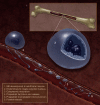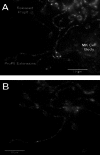The incredible journey: From megakaryocyte development to platelet formation
- PMID: 23751492
- PMCID: PMC3678154
- DOI: 10.1083/jcb.201304054
The incredible journey: From megakaryocyte development to platelet formation
Abstract
Circulating blood platelets are specialized cells that prevent bleeding and minimize blood vessel injury. Large progenitor cells in the bone marrow called megakaryocytes (MKs) are the source of platelets. MKs release platelets through a series of fascinating cell biological events. During maturation, they become polyploid and accumulate massive amounts of protein and membrane. Then, in a cytoskeletal-driven process, they extend long branching processes, designated proplatelets, into sinusoidal blood vessels where they undergo fission to release platelets. Given the need for platelets in many pathological situations, understanding how this process occurs is an active area of research with important clinical applications.
Figures




References
-
- Aster R.H. 1967. Studies of the mechanism of “hypersplenic” thrombocytopenia in rats. J. Lab. Clin. Med. 70:736–751 - PubMed
-
- Avecilla S.T., Hattori K., Heissig B., Tejada R., Liao F., Shido K., Jin D.K., Dias S., Zhang F., Hartman T.E., et al. 2004. Chemokine-mediated interaction of hematopoietic progenitors with the bone marrow vascular niche is required for thrombopoiesis. Nat. Med. 10:64–71 10.1038/nm973 - DOI - PubMed
Publication types
MeSH terms
Grants and funding
LinkOut - more resources
Full Text Sources
Other Literature Sources

